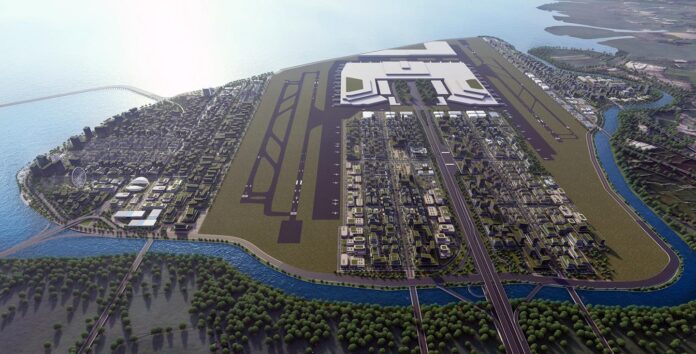
-
SMC chairman Ramon Ang says multimodal transport options are key to unlocking the country’s true economic potential
-
Ongoing infrastructure projects reflect the group’s multimodal concept combining airport, mass railway, expressways to eliminate costly road congestion and inefficiencies
-
Crowning these projects will be the nearly P1 trillion New Manila International Airport in Bulacan that is expected to open in the third quarter of 2026
San Miguel Corp., the largest multinational conglomerate in the Philippines, believes multimodal infrastructure projects are key to unlocking the country’s true economic potential that will take it to closer to developed nation status.
This conviction was likely behind the group’s change from a purely food and beverage producer in recent decades to an active participant in the Philippine government’s big-ticket projects.
SMC’s infrastructure projects reflect the group’s multimodal concept. These are the New Manila International Airport in Bulacan; the Mass Rail Transit 7 (MRT-7) project linking Quezon City and the rest of Metro Manila to Bulacan; the South Luzon Expressway (SLEX) Toll Road (TR) 4 project that will extend SLEX from Sto. Tomas, Batangas to Lucena City, Quezon province, and the upcoming SLEX TR5 from Lucena all the way to Matnog, Sorsogon.
“Our infrastructure projects – airport, mass railway, expressways – will eliminate congestion and inefficiencies that cost our people and economy billions in losses every day,” SMC chairman Ramon Ang said at the annual stockholders meeting of the group on June 15.
He was referring to the daily traffic jams in Metro Manila that has gotten worse over the years. A study by the Japan International Cooperation Agency estimated the gridlock was costing the economy P3.5 billion daily, with losses likely to grow to P5.4 billion a day by 2035 if no interventions are made.
“There are many projects in various stages of development throughout the San Miguel Group. What is common to all these projects is our stronger push for nation-building, and towards greater sustainability,” Ang said.
Work is in full swing at the nearly ₱1 trillion New Manila International Airport and Bulacan Airport City in Bulakan, the largest among SMC infrastructure projects. Commercial operations are expected to begin in less than four years’ time, Ang said.
He said the company has housed some 1,500 workers on a cruise ship to ensure they are protected from the coronavirus so that construction will not be hampered by lockdowns. He said no one is allowed to go home and work is on a 24/7 basis in shifts.
Barring any lockdowns, the airport platform could be done by the third quarter of 2024, so SMC can build the runway, taxiway, apron, passenger terminal, carpark block, and road network. All project parts should be ready in time for the airport’s commercial opening in the first quarter of 2026.
Financing for the airport project has the seal of approval from the Dutch government, which granted the airport contractor a guarantee for a 14-year loan.
When completed, the Bulacan airport will be Luzon’s biggest gateway, is expected to have an annual passenger traffic of 100 million, eclipsing those of the Ninoy Aquino International Airport (NAIA) and the Clark International Airport.
Ang said SMC is also investing at least US$1 billion (around P63 billion) to build 31 battery energy storage facilities nationwide with a capacity of 1,000 megawatts to ensure stable and reliable power supply to more provinces.
He said the battery storage project would complement SMC’s planned additional investments in renewable energy, which include new baseload capacities using natural gas to ensure that the growing power needs of the developing economy are met over the long term.
Ang said SMC is expanding its food manufacturing capacities in various regions, with plans to set up agro-industrial and special economic zones to drive regional growth and spur job creation.
SMC reported strong performance for 2021, with all major businesses turning in higher volume, revenue and income results. Net profit jumped 120% to P48.2 billion as consolidated revenues rose 30% to P941.2 billion.
The company’s growth momentum carried through to the first quarter of 2022, with profit rising 19% to P13.9 billion.





Yes, Multimodal transport system is the future! Only in the past decades have our streets become increasingly car-centric.
A reversal of this trend by expanding other transportation modes and technologies can create a more equitable, inclusive, and accessible transportation environment. Our Cities and Towns can achieve this through a new transportation planning paradigm based in comprehensive and multimodal planning. Most importantly, this planning must put communities at the forefront.
The new paradigm defines transportation as accessibility, centered in people’s ability to obtain transportation services and participate in activities. Transportation planning and design should reduce the cost of transportation while also improving opportunities for disadvantaged populations, our overall health and public fitness, pollution, and energy conservation.
Reducing traffic congestion, crash rates, and vehicle costs, which were the old planning goals, should not be the only considerations. We need multimodal systems that efficiently manage transportation demand and accessibility for all communities.
Comments are closed.